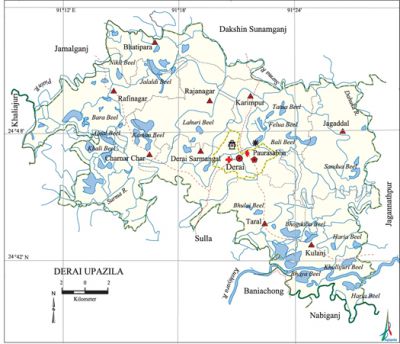Derai Upazila
Derai Upazila (sunamganj district) area 420.93 sq km, located in between 24°39' and 24°53' north latitudes and in between 91°10' and 91°28' east longitudes. It is bounded by dakshin sunamganj and jamalganj upazilas on the north, sulla, baniachang and nabiganj upazilas on the south, jagannathpur upazila on the east, Sulla, khaliajuri and Jamalganj upazilas on the west.
Population Total 243690; male 122636, female 121054; Muslim 179222, Hindu 64285, Buddhist 11, Christian 78 and others 94.
Water bodies Main rivers: surma, kushiyara, Dahuka; Ainal, Tatua, Jalaldi, Haria and Bhogdoba beels are notable.
Administration Derai Thana was formed in 1942 and it was turned into an upazila in 1982.
| Upazila | ||||||||
| Municipality | Union | Mouza | Village | Population | Density (per sq km) | Literacy rate (%) | ||
| Urban | Rural | Urban | Rural | |||||
| 1 | 9 | 137 | 232 | 36183 | 207507 | 579 | 49.8 (2001) | 33.4 |
| Municipality | ||||||||
|
Area |
Ward |
Mahalla |
Population |
Density |
Literacy rate | |||
| 6.50 (2001) | 9 | 29 | 28157 | 3489 (2001) | 60.0 | |||
| Upazila Town | ||||||||
|
Area |
Mouza |
Population |
Density |
Literacy rate | ||||
| 2.90 (2001) | 4 | 8026 | 2215 (2001) | 47.9 | ||||
| Union | ||||
| Name of union and GO code | Area (acre) | Population | Literacy rate (%) | |
| Male | Female | |||
| Karimpur 47 | 10159 | 13283 | 12972 | 42.5 |
| Kulanj 57 | 13293 | 14409 | 14692 | 37.3 |
| Charnar Char 19 | 12430 | 13489 | 12875 | 32.6 |
| Jagaddal 38 | 13097 | 14636 | 15005 | 36.5 |
| Taral 85 | 9833 | 10410 | 10243 | 34.2 |
| Derai Sarmangal 28 | 10897 | 7638 | 7522 | 27.1 |
| Bhatipara 17 | 9365 | 9982 | 9883 | 31.4 |
| Rafinagar 66 | 12764 | 12309 | 11709 | 23.3 |
| Rajanagar 76 | 10577 | 12226 | 12250 | 35.8 |
Source Bangladesh Population Census 2011,Bangladesh Bureau of Statistics.

Archaeological heritage and relics Shyamar Char Akhra, Mazar of Wakil Shah, Mazar of Lengta Shah, Bhatipara Mosque, Hosenpur Mosque.
Historical events Nankar Rebellion was held in this upazila in 1938.
War of Liberation Freedom fighters had an encounter with the Pak army on 25 August 1971, in which freedom fighters Azim Ullah, Kuti Miah and Gopendra Das were killed and Abdul Khaleque and Company Commandar Ataur Rahman were wounded. There is a mass grave and a mass killing site in the upazila.
For details: see লক্ষ্মীপুর সদর উপজেলা, বাংলাদেশ মুক্তিযুদ্ধ জ্ঞানকোষ (Encyclopedia of Bangladesh War of Liberation), বাংলাদেশ এশিয়াটিক সোসাইটি, ঢাকা ২০২০, খণ্ড ৯।
Religious institutions Mosque 253, temple 15, tomb 6.
Literacy rate and educational institutions Average literacy 37.1%; male 38.5%, female 35.8%. Noted educational institutions: Derai Degree College (1979), Derai Boys' High School (1915), Derai Girls' High School (1958), Fakir Mohammad Ideal High School (1987), Rajanagar Krishnachandra Public Secondary School (1903), Derai Ideal Government Primary School (1805), Derai Jamea Hafizia Hossainia Madrasa (1978).
Cultural organisations Club 80, Library 1, cinema hall 2, theatre stage 1, jatra group 4, women organisation 2, cultural organisation 5.
Main sources of income Agriculture 74.85%, non-agricultural labourer 5.30%, industry 0.24%, commerce 8.14%, transport and communication 0.26%, service 3.19%, construction 0.64%, religious service 0.38%, rent and remittance 0.70% and others 6.30%.
Ownership of agricultural land Landowner 49.11%, landless 50.89%; agricultural landowner: urban 43.25% and rural 50.04%.
Main crops Paddy, chilli, potato, onion, vegetables.
Extinct or nearly extinct crops Jute.
Main fruits Mango, jackfruit, wood-apple, banana, litchi, blackberry, guava.
Fisheries, dairies and poultries Fishery 150, hatchery 5, poultry 120.
Communication facilities Pucca road 106 km, semi-pucca road 20 km, mud road 322 km; waterway 21 km.
Extinct or nearly extinct traditional transport Palanquin, horse carriage.
Noted manufactories Rice mill 12, flour mill 2, saw mill 8, brick-field 5, ice factory 3, pipe factory 1.
Cottage industries Weaving and bamboo work.
Hats, bazars and fairs Hats and bazars are 20, fairs 2, most noted of which are Derai, Rajanagar, Tanakhali, Ratanganj, Bhatipara, Shyamar Char, Banglabazar and Dhalbazar and Dhal Mela.
Main exports Fish.
Access to electricity All the wards and unions of the upazila are under rural electrification net-work. However 35.4% of the dwelling households have access to electricity.
Sources of drinking water Tube-well 93.4%, tap 0.2% and others 6.47%. The presence of arsenic in an intolerable level has been detected in 3% shallow tube-well water of the upazila.
Sanitation 36.4% of dwelling households of the upazila use sanitary latrines and 51.9% of dwelling houses use non-sanitary latrines; 11.7% of households do not have latrine facilities.
Access to electricity All the wards and unions of the upazila are under rural electrification net-work. However 9.93% of the dwelling households have access to electricity.
Sources of drinking water Tube-well 76.30%, pond 13.23%, tap 7% and others 3.47%. The presence of arsenic in an intolerable level has been detected in 3% shallow tube-well water of the upazila.
Sanitation 26.36% (rural 22.62% and urban 49.94%) of dwelling households of the upazila use sanitary latrines and 58.78% (rural 61.43% and urban 42.13%) of dwelling households use non-sanitary latrines; 14.86% of households do not have latrine facilities.
Health centres Upazila health centre 1, health and family planning welfare centre 13, satellite clinic 2, tuberculosis (TB) hospital run by brac 1, leprosy hospital run by HEED Bangladesh 1, community clinic 15, veterinary hospital 1.
Natural disasters The floods of 1974 and 1988 and the tsunami of 2004 caused heavy damages to settlements and properties of the upazila.'
NGO activities Operationally important NGOs are brac, HEED Bangladesh, Grameen Janakolyan Sangstha. [Jiban Kumar Chanda]
References Bangladesh Population Census 2001 and 2011, Bangladesh Bureau of Statistics; Cultural survey report of Derai Upazila 2007.
